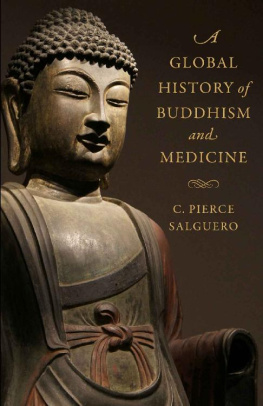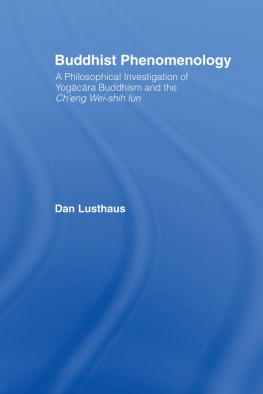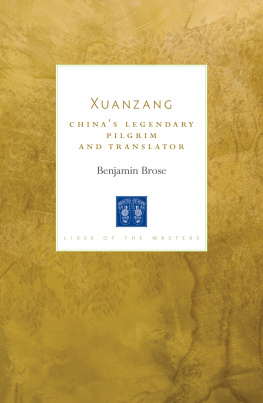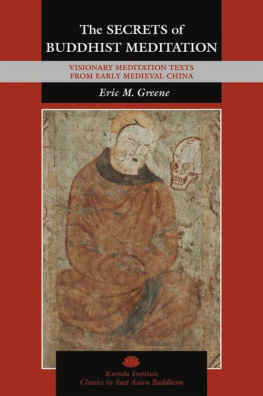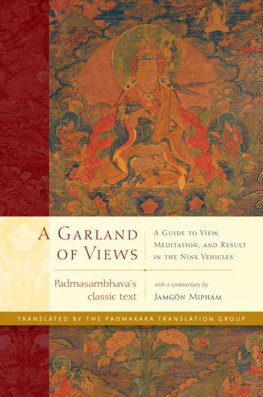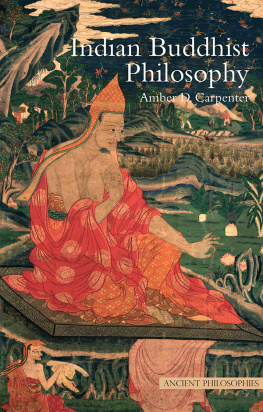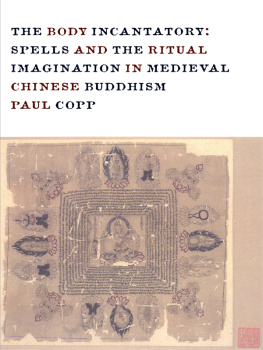C. Pierce Salguero - Translating Buddhist Medicine in Medieval China
Here you can read online C. Pierce Salguero - Translating Buddhist Medicine in Medieval China full text of the book (entire story) in english for free. Download pdf and epub, get meaning, cover and reviews about this ebook. year: 2014, publisher: University of Pennsylvania Press, genre: Religion. Description of the work, (preface) as well as reviews are available. Best literature library LitArk.com created for fans of good reading and offers a wide selection of genres:
Romance novel
Science fiction
Adventure
Detective
Science
History
Home and family
Prose
Art
Politics
Computer
Non-fiction
Religion
Business
Children
Humor
Choose a favorite category and find really read worthwhile books. Enjoy immersion in the world of imagination, feel the emotions of the characters or learn something new for yourself, make an fascinating discovery.

- Book:Translating Buddhist Medicine in Medieval China
- Author:
- Publisher:University of Pennsylvania Press
- Genre:
- Year:2014
- Rating:3 / 5
- Favourites:Add to favourites
- Your mark:
- 60
- 1
- 2
- 3
- 4
- 5
Translating Buddhist Medicine in Medieval China: summary, description and annotation
We offer to read an annotation, description, summary or preface (depends on what the author of the book "Translating Buddhist Medicine in Medieval China" wrote himself). If you haven't found the necessary information about the book — write in the comments, we will try to find it.
Translating Buddhist Medicine in Medieval China — read online for free the complete book (whole text) full work
Below is the text of the book, divided by pages. System saving the place of the last page read, allows you to conveniently read the book "Translating Buddhist Medicine in Medieval China" online for free, without having to search again every time where you left off. Put a bookmark, and you can go to the page where you finished reading at any time.
Font size:
Interval:
Bookmark:
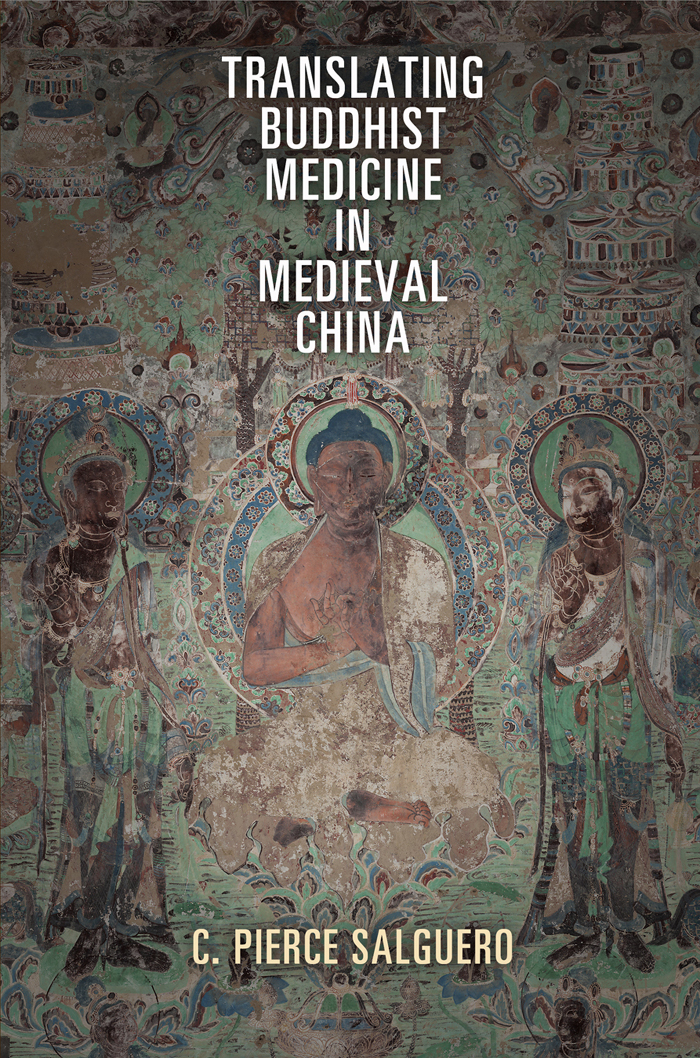
Translating
Buddhist Medicine
in Medieval China
ENCOUNTERS WITH ASIA
Victor H. Mair, Series Editor
Encounters with Asia is an interdisciplinary series dedicated to the exploration of all the major regions and cultures of this vast continent. Its time frame extends from the prehistoric to the contemporary; its geographic scope ranges from the Urals and the Caucasus to the Pacific. A particular focus of the series is the Silk Road in all of its ramifications: religion, art, music, medicine, science, trade, and so forth. Among the disciplines represented in this series are history, archaeology, anthropology, ethnography, and linguistics. The series aims particularly to clarify the complex interrelationships among various peoples within Asia, and also with societies beyond Asia.
A complete list of books in the series is available from the publisher.
TRANSLATING
BUDDHIST MEDICINE
IN MEDIEVAL CHINA
C. Pierce Salguero

UNIVERSITY OF PENNSYLVANIA PRESS
PHILADELPHIA
Copyright 2014 University of Pennsylvania Press
All rights reserved. Except for brief quotations used for purposes of review or scholarly citation, none of this book may be reproduced in any form by any means without written permission from the publisher.
Published by
University of Pennsylvania Press
Philadelphia, Pennsylvania 19104-4112
www.upenn.edu/pennpress
Printed in the United States of America on acid-free paper
2 4 6 8 10 9 7 5 3 1
A Cataloging-in-Publication record is available from the
Library of Congress
ISBN 978-0-8122-4611-7
For Maxine and Simone
CONTENTS
Introduction
With translation there is transmission; without translation there is but obscurity.
Sengyou (445518)
The transmission of Buddhism from India to China in the first millennium of the Common Era ranks among the most significant and most well documented examples of cross-cultural exchange in the premodern world. Although the study of the global spread of Buddhism is most commonly undertaken by scholars of religion, this cross-cultural encounter involved much more than simply the transmission of religious or philosophical knowledge. Buddhism influenced many other aspects of Chinese life, including contributing to the economy, inspiring changes in the sociopolitical order, and spurring the adoption of foreign material culture. This book is a study of one, often-overlooked facet of this Indo-Sinitic exchange: the introduction of Indian medicine to China.
Knowledge about health and illness held a central place within Buddhist thought from the earliest times.body is the very essence of the Buddhas teachings. Taken collectively, such Buddhist perspectives on health, illness, healers, patients, therapies, and bodies are today often spoken of by East Asian scholars and devotees as Buddhist medicine (Ch. foyi or fojiao yixue; Jp. bukky igaku).
Buddhist medicine, if I may employ that term here for purposes of convenience, is a moving target. It represents a loose collection of ideas and practices that originated in the Indo-European context in the latter centuries B.C.E., but that was modified and expanded as a result of cross-cultural interactions during the vigorous geographical expansion of Buddhism. Transmitted along the networks of land and sea trade routes, the core doctrines and perspectives of Buddhist medicine came to exert a powerful influence on medical thought and practice across a large swath of Eurasia. To this day, they continue to form the basis of traditional medicine in Sri Lanka, Thailand, and Tibet, among other places. However, the history of how the tradition was locally received, understood, and transformed differed greatly from place to place.
The Chinese reception of Buddhist medicine was complex and multi-faceted. Medieval China was culturally diverse and politically fractured, and therefore itlike virtually all other facets of Buddhismwas subject to multiple interpretations in different contexts. China also had long-established repertoires of ritual healing, bodily self-cultivation, and alchemical experimentation that claimed to be able to heal, to prevent illness, and even to confer immortality. Over the long term, the impact of some aspects of Buddhist medicine on the Chinese medical world was profound: Indian-inspired healing deities, rituals, occult practices, and hagiography, for example, all proved to be enormously popular and permanent contributions to Chinese culture. At the same time, some doctrines that lay at the very center of Buddhist medical thought and practice were perceived as conflicting with indigenous precedents. In the long run, these failed to catch on and were ultimately either ignored or actively replaced by homegrown models within Buddhist discourses.
I am planning future publications that will provide in-depth analysis of the medical content of Chinese Buddhist texts, the relationship between this medical system and others throughout Eurasia, and the historical development of Buddhist medicine in a global context. The present book focuses on understanding the local reception of Buddhist medical ideas in China. While it starts with an overview of the transmission of Buddhist medical knowledge to China, the majority of its pages are dedicated to exploring the processes of translation involved in this historic episode of cross-cultural exchange. The many Chinese Buddhist writings under consideration in this book demonstrate that foreign medical ideas introduced along with Buddhism were voluminously translated, enthusiastically commented upon, and widely disseminated in China. At the same time, however, they show that translators went to great lengths to adapt Indian ideas and practices to domestic cultural and social contexts. Far from passively being influenced by transmitted knowledge from abroad, they actively retooled these imports to fit with Chinese intellectual concerns, to mesh with preexisting literary and cultural conventions, and to forward their own political and economic interests.
The examination of these dynamics of cross-cultural transmission and reception will bring into sharper focus several important facets of religious and medical history that are worth highlighting from the outset. In the first place, Chinese Buddhist texts dealing with medicine throw into question some of the basic assumptions about the history of Indian medicine, not least of which is the tendency to label all ancient Indian medical knowledge as yurveda. Clearly, there were significant currents of medical thought outside of the yurvedic context. Second, and from a more global standpoint, these texts showcase the centrality of healing as one of the most important mechanisms by which Buddhism gained prominence outside of India. They demonstrate how the body and its processes of health and illness could be used as effective tools for translating Buddhist doctrines across geographic, ethnic, and linguistic divides, and how engaging with medical knowledge helped Buddhists position themselves as cross-cultural mediators.
At the same time, the study of these texts also greatly enhances our understanding of the local religious and medical context in medieval China. That is the main focus of the current book. Focusing on the Chinese reception of Buddhist medicine underscores how the history of Chinese medicine is inseparable from that of Chinese religion, and vice versa. It helps us to understand the medieval Chinese religious and medical landscape, and the roles of Buddhist ideas, practices, and practitioners in that world. It sheds light on the multivalence of healing knowledge in medieval society and its significance as a site of political and social contestation. It highlights the importance of clerics as health-care practitioners, the tensions between them and other groups of healing specialists, and the role of religion in their processes of differentiation. And, at a more fundamental level, this study strongly urges us to think of historical processes of cross-cultural exchange as creative moments that hinged on the translational activities of individual historical actors.
Font size:
Interval:
Bookmark:
Similar books «Translating Buddhist Medicine in Medieval China»
Look at similar books to Translating Buddhist Medicine in Medieval China. We have selected literature similar in name and meaning in the hope of providing readers with more options to find new, interesting, not yet read works.
Discussion, reviews of the book Translating Buddhist Medicine in Medieval China and just readers' own opinions. Leave your comments, write what you think about the work, its meaning or the main characters. Specify what exactly you liked and what you didn't like, and why you think so.

